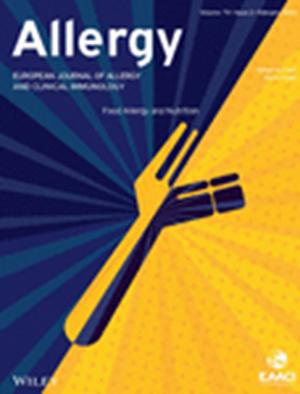使用真实世界材料的花生过敏成人口服免疫治疗
IF 12.6
1区 医学
Q1 ALLERGY
引用次数: 0
摘要
花生口服免疫疗法(OIT)在实现儿童脱敏方面已显示出有效性;然而,在成人中缺乏证据。方法本II期试验评估花生过敏成人使用真实世界花生产品的花生油脂含量。采用了Simon的极大极小两阶段设计,并结合了停止:去无用。另外还招募了一个单独的未经治疗的对照组进行力学参数的比较。参与者接受基线双盲安慰剂对照食物挑战(DBPCFC),花生蛋白剂量为0.3至300毫克。有反应的参与者开始每日服用OIT,每2周增加剂量,直到达到维持剂量1000mg(4个大花生)。主要结局是在退出DBPCFC期间耐受累计剂量1.4 g花生蛋白的OIT参与者的比例(剂量提供0.3‐3000 mg)。结果成人21例(女性8例;平均年龄24.2岁[SD 4.9])纳入OIT组,67%达到每日维持剂量并达到主要终点。三人因不良反应退出,另有三人因与OIT无关的原因没有完成试验。中位耐受剂量从30毫克(大约相当于1/8个花生)增加到3000毫克(12个花生),增加了100倍(p <;0.0001)。OIT与生活质量的改善有关。在OIT中观察到花生皮肤点刺试验大小的抑制和花生特异性IgG的诱导,而在对照组中则没有。结论花生油是治疗成人花生过敏的有效方法。需要进一步的研究来证实并确定不同成人亚组的安全性概况。成人花生免疫治疗(GUPI)研究;ClinicalTrials.gov识别码:NCT03648320本文章由计算机程序翻译,如有差异,请以英文原文为准。
Oral Immunotherapy in Peanut‐Allergic Adults Using Real‐World Materials
BackgroundPeanut oral immunotherapy (OIT) has shown effectiveness in achieving desensitization of children; however, evidence in adults is lacking.MethodsThis phase II trial evaluated peanut OIT in peanut‐allergic adults using real‐world peanut products. A Simon's minimax two‐stage design, incorporating a stop:go for futility, was employed. A separate untreated control group was also recruited for comparison of mechanistic parameters. Participants underwent baseline double‐blind placebo‐control food challenges (DBPCFC) with peanut protein doses of 0.3 to 300 mg. Reacting participants were initiated on daily OIT with 2‐weekly updosing until reaching a maintenance dose of 1000 mg (four large peanuts). The primary outcome was the proportion of OIT participants who tolerated a cumulative dose of 1.4 g peanut protein during exit DBPCFC (doses provided 0.3‐3000 mg).ResultsTwenty‐one adults (8 female; mean age 24.2 years [SD 4.9]) were enrolled in the OIT group, with 67% achieving the daily maintenance dose and meeting the primary endpoint. Three withdrew due to adverse reactions, and a further three did not complete the trial for reasons unrelated to OIT. The median tolerated dose increased from 30 mg (equivalent to approximately 1/8th of a peanut) to 3000 mg (12 peanuts) at the exit challenge, representing a 100‐fold increase (p < 0.0001). OIT was associated with an improvement in QoL measures. Suppression of peanut skin prick test sizes and induction of peanut‐specific IgG were observed in OIT but not in control participants.ConclusionsPeanut OIT appears to be an efficacious treatment for adults with peanut allergy. Further studies are needed for confirmation and to characterize safety profiles in different adult subgroups.Trial RegistrationGrown Up Peanut Immunotherapy (GUPI) study; ClinicalTrials.gov identifier: NCT03648320
求助全文
通过发布文献求助,成功后即可免费获取论文全文。
去求助
来源期刊

Allergy
医学-过敏
CiteScore
26.10
自引率
9.70%
发文量
393
审稿时长
2 months
期刊介绍:
Allergy is an international and multidisciplinary journal that aims to advance, impact, and communicate all aspects of the discipline of Allergy/Immunology. It publishes original articles, reviews, position papers, guidelines, editorials, news and commentaries, letters to the editors, and correspondences. The journal accepts articles based on their scientific merit and quality.
Allergy seeks to maintain contact between basic and clinical Allergy/Immunology and encourages contributions from contributors and readers from all countries. In addition to its publication, Allergy also provides abstracting and indexing information. Some of the databases that include Allergy abstracts are Abstracts on Hygiene & Communicable Disease, Academic Search Alumni Edition, AgBiotech News & Information, AGRICOLA Database, Biological Abstracts, PubMed Dietary Supplement Subset, and Global Health, among others.
 求助内容:
求助内容: 应助结果提醒方式:
应助结果提醒方式:


